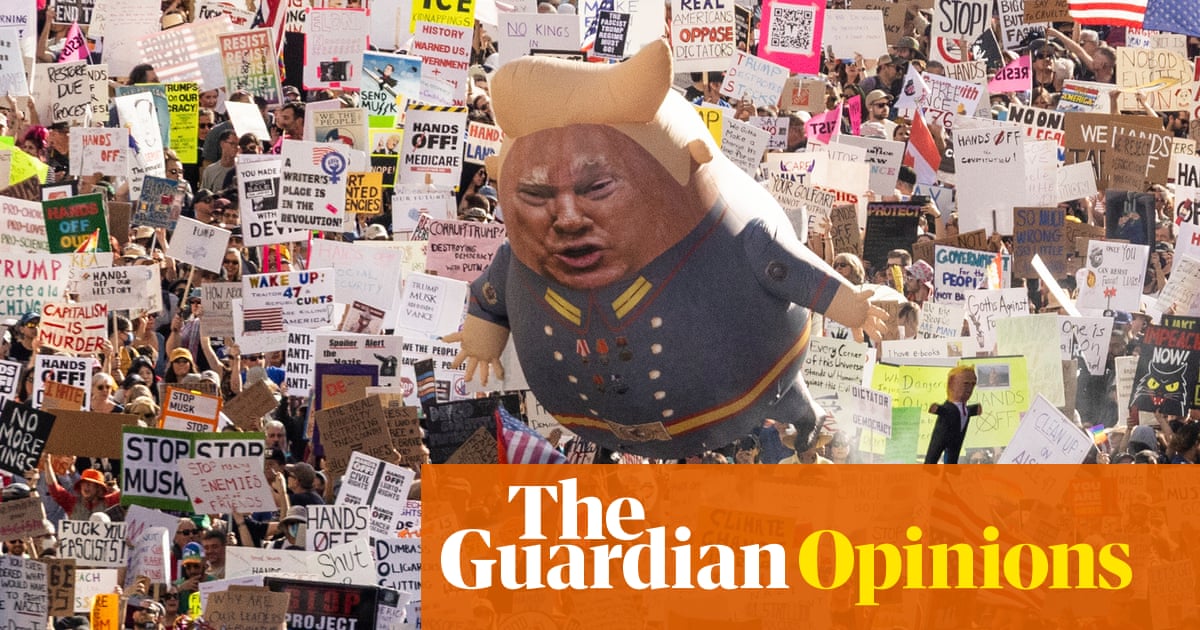When hundreds of thousands of Americans gathered across the US on 5 April for the“Hands Off” eventsprotesting Donald Trump and Elon Musk’s governmental wrecking ball, much of the news media seemed to yawn.
The next day, the New York Times put a photograph, but no story, on its print front page. The Wall Street Journal’s digital homepage had it as only the 20th-most-prominent story when I checked. Fox News was dismissive; I stopped counting after I scanned 40 articles on its homepage, though there was a video with this dismissive headline: “Liberals rally against President Trump.”
The Guardian, CNN and some local news outlets paid more heed. The cable network offered live video from many American cities and a banner headline: “Millions of people protest against Trump & Musk.”
But overall, there was something of a shrug about the media coverage. It got much more attention from global news outlets than in the US.
The US media will get a chance to atone for these sins of omission this coming weekend when Americans once again get together, this time for Saturday’s “No Kings” day, which organizers describe as “a nationwide day of defiance”.
“From city blocks to small towns, from courthouse steps to community parks, we’re taking action to reject authoritarianism,” they say. More than 100 pro-democracy groups are involved, according toAxios.
It’s expected to be the largest anti-Trump protest since the start of his second term, according to organizers who are planning rallies in 1,500 cities in all 50 states. It’s happening, in part, as a reaction to the military parade in Washington DC that Trump has planned on his 79th birthday and the US army’s 250th anniversary.
Of course, the citizen protests in Los Angeles against federal Ice agentshavereceived a great deal of attention, although the media focus has largely been on the conflict between law enforcement and protesters. Those protests, and the deep concern over the Trump administration’s action, with its authoritarian overtones, are likely to bring even more people out to rallies across the country on Saturday.
I don’t know how many people will show up, but I do believe it matters.
And I have good reason to think so.
A study from a Harvard University political scientist presents a statistic worth remembering: that, around the world,once 3.5%of the population became engaged in sustained and non-violent campaigns of resistance, change has always happened.
Erica Chenoweth, the academic researcher who conducted the study, was surprised by what her team found.
“I was really motivated by some skepticism that non-violent resistance could be an effective method for achieving major transformations in society,” Chenowethsaidin a 2019 BBC interview.
But her skepticism was overcome as the study turned up clear results. As one example of many she cites: in 1986, the Marcos regime folded after the fourth day of millions of Filipino citizens taking the streets of Manila.
Non-violent protests, she found, are much more effective – and bring about more lasting change – than armed conflict.
In the US, that 3.5% of the adult population is roughly 9 million people – about the population of New York City. That’s a high bar, many more people than showed up on 5 April.
The encouraging thing is that real change is possible.
However, if journalists consistently look the other way, the power of peaceful citizen protests can fade.
In myAmerican Crisis newslettertwo days after the 5 April protests, I offered a few theories for why the media may seem so blasé.
First, I posited, much of the mainstream media tends to view this much as Fox News does. The protesters are just the usual suspects – “liberals” – doing the predictable thing.
Second, many large media companies are afraid that prominent protest coverage will be criticized by the political right as partisan, and they can’t bear that label.
Third, corporate media decision-makers, always focused the bottom line, are fearful of losing right-leaning readers and viewers; yes, we’ll cover this, they seem to say, butquietly, since we don’t want to antagonize anyone. In an era in which Trump has attempted to bully the press into submission, through denying access and throughlawsuits, cowardice and capitulation are all too common.
In the end, it’s up to the American people. Do enough of them care enough about democracy, decency and the rule of law to leave their easy chairs, barbecues and sports-gambling apps to get out in the streets and make their voices heard?
If the protests grow large enough, and sustained enough, even the most reluctant media will have little choice but to pay attention.
Margaret Sullivan is a Guardian US columnist writing on media, politics and culture
